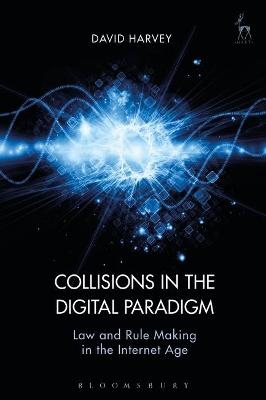
Collisions in the Digital Paradigm
Hart Publishing (Verlag)
978-1-5099-0652-9 (ISBN)
David J Harvey, formerly a District Court Judge sitting in Auckland, New Zealand, is Director of the New Zealand Center for ICT Law a part-time lecturer in Law and Information Technology, both at the Faculty of Law, University of Auckland.
1. Introduction
2. The Analytical Framework
I. Introduction
II. Elizabeth Eisenstein and the Qualities of Print
III. Digital Information
IV. Conclusion
3. The Transition to the Digital Paradigm—Analogies and Functional Equivalence
I. Introduction
II. A Historical Perspective
III. Digital Writing
IV. Change and Communication in the Digital Paradigm
V. The Law’s Approach to Equating the Old with the New
VI. Functional Equivalence
VII. The Problem of Analogies
VIII. Conclusion
4. Aspects of Internet Governance
I. Introduction
II. The Internet Governance Forum
III. Technical Governance
IV. Models of Internet Governance
V. Conclusion
5. The Property Problem
I. Introduction
II. Information as Property—The Debate in the Digital Paradigm
III. The British Commonwealth Approach
IV. The United States’ Position
V. Property or Cyberproperty
VI. Conclusion
6. Recorded Law—The Twilight of Precedent in the Digital Age
I. Introduction
II. Law and Precedent in the Print and Digital Paradigms
III. The Twilight of Precedent?
7. Digital Information—The Nature of the Document and E-discovery
I. Introduction
II. The Development of E-discovery Rules
III. Common Themes in the Development of E-discovery in Asia-Pacific Jurisdictions
IV. The Rules and Utilisation of Technology
V. Conclusion
8. Evidence, Trials, Courts and Technology
I. Introduction
II. Orality and Physical Presence of Witnesses
III. Facing Up to Change
IV. Technology in Court
V. The Next Phase
VI. Using Technology to Change Process Models
VII. Conclusion
9. Social Media
I. Introduction
II. What is Social Media?
III. Social Media Meets the Law
IV. The Googling Juror
V. Lost in Translation—Interpreting Social Media Messages
VI. Other Aspects of Social Media
VII. Conclusion
10. Information Persistence, Privacy and the Right to be Forgotten
I. Introduction
II. Privacy Themes
III. Privacy Taxonomies
IV. Obscurity of Information—Practical and Partial Obscurity
V. Judicial Approaches
VI. The Internet and Privacy
VII. Search Engines and Information Retrievability
VIII. The Right to be Forgotten
IX. A Right to Update?
X. Conclusion
11. Reputational Harms
I. Introduction
II. The Publication Issue
III. Google and Defamation
IV. Linking and Publication
V. Reputational Harms—Where Defamation Does Not Tread
VI. Triaging Reputation
VII. Conclusion
12. Conclusion
I. The Qualities of Digital Information
II. Governance of a Distributed, Dynamic, Changing Environment?
III. Behavioural Change and Values
IV. Old Rules in New Bottles—Seeking Consistency
V. Volume, Dissemination and Availability of Information
VI. Participation, Interactivity and the Message
VII. Who Am I Online?
VIII. The Message is the Medium—What the Law must Recognise
| Erscheinungsdatum | 23.03.2017 |
|---|---|
| Verlagsort | Oxford |
| Sprache | englisch |
| Maße | 156 x 234 mm |
| Gewicht | 761 g |
| Themenwelt | Recht / Steuern ► EU / Internationales Recht |
| Recht / Steuern ► Privatrecht / Bürgerliches Recht ► Berufs-/Gebührenrecht | |
| Recht / Steuern ► Privatrecht / Bürgerliches Recht ► IT-Recht | |
| ISBN-10 | 1-5099-0652-5 / 1509906525 |
| ISBN-13 | 978-1-5099-0652-9 / 9781509906529 |
| Zustand | Neuware |
| Haben Sie eine Frage zum Produkt? |
aus dem Bereich


